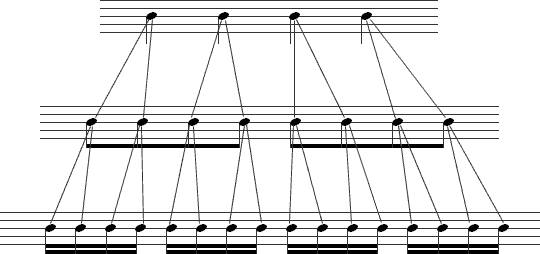What You Should Know
What You Will Learn
- How sixteenth notes are notated
- How to count sixteenth notes
- Dotted eighth notes
How to Count Sixteenth Notes and Dotted Eighth Notes
What is a Sixteenth Note?
A sixteenth note has two flags or beams:

Sixteenth notes are one fourth of a beat in 4/4 time. This means that there are four sixteenth notes in a quarter note and two sixteenths in an eighth note.
Subdividing with Sixteenth Notes
The chart below illustrates the subdivision from quarter notes to sixteenth notes:

Counting Sixteenth Notes
Counting Straight Sixteenth Notes
Straight sixteenth notes should be counted in 4/4 by saying, 'one e and a, two e and a, three e and a, four e and a'.

Counting Mixed Rhythms with Sixteenth Notes
Sixteenth note rhythms mixed with other rhythms can be counted using the sixteenth note subdivision (one e and a, etc.) or by counting just the smallest subdivision on each beat. For example, the following passage includes quarter notes, eighth notes, and sixteenth notes.

You can also count this passage by counting the smallest subdivision for each beat. For example, if the smallest note value on a beat is an eighth note, you don't need to count anything smaller than an eighth note for that beat. Below is the same passage again with the count changed to use this approach:

Counting steady sixteenth notes does work, but it can be difficult at faster tempos. It is better to get used to counting the smallest subdivision for each beat so that you aren't counting unnecessarily.
Common Sixteenth Note Rhythms
There are several sixteenth note rhythms that you will encounter frequently. Many of these rhythms can be counted several ways, both by counting each sixteenth note and by counting only when a note occurs. You may want to start by counting every sixteenth to improve your rhythmic accuracy at first. Once you are comfortable with each rhythm, you can omit the optional counts shown in parentheses. These rhythms are discussed below.
Gallop
A gallop is an eighth note followed by two sixteenth notes. It is known as a gallop rhythm because it resembles the sound of a horse galloping. These rhythms can be counted by counting 'one and a, two and a, three and a, four and a' as in the example below:

If you currently count triplets using 'one and a, two and a, etc.', you may want to consider using one of the other methods to avoid confusion with the count used for the gallop rhythm.
Reverse Gallop
The reverse gallop rhythm is a pattern of two sixteenth notes followed by an eighth note. It can be counted by counting 'one e and, two e and, three e and, four e and' as shown below:

You can choose the approach that works best for you. Keep in mind that the more you count the more difficult it is to count at faster tempos.
Sixteenth Eighth Sixteenth
The sixteenth - eighth - sixteenth rhythm is another common rhythm that mixes sixteenth notes and eighth notes. This rhythm is generally counted by counting all of the sixteenth notes. However, it is possible to omit the 'and' from the count.

The Dotted Eighth Note
A dotted eighth note is an eighth note with a dot after it. Since a dot adds half the value of the note after which it appears, the dotted eighth note is equal to three sixteenth notes or 3/4 of a beat in 4/4 time. Dotted eighth notes are frequently used with a sixteenth note to form a quarter note beat in time signatures such as 4/4. There are two rhythm patterns possible when combining the dotted eighth and a sixteenth note:
Dotted Eighth - Sixteenth Rhythm
This is the more common pattern involving dotted eighth notes and sixteenth notes. It can be counted by counting all of the sixteenth notes or by counting only when there is a note as shown below:

Sixteenth Note - Dotted Eighth Rhythm
This rhythm can be counted by counting all sixteenth notes or by counting 'one e, two e, etc.' This is shown in the example below with the optional words enclosed in parentheses:

